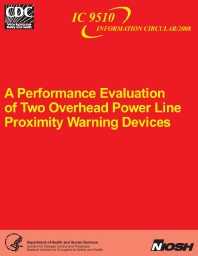Mining Publication: A Performance Evaluation of Two Overhead Power Line Proximity Warning Devices
Original creation date: November 2008
Accidental contact of overhead electrical power lines by mobile equipment is a leading cause of occupational fatalities in the United States, accounting for 20% of on-the-job electrocutions. Overhead electrical power line proximity warning devices (PWDs) are intended to warn personnel if mobile equipment moves within some preselected minimum distance of an energized overhead electrical power line. Two commercially available PWDs were tested at the National Institute for Occupational Safety and Health's (NIOSH) Pittsburgh Research Laboratory (PRL). The objective of the tests was to document performance capabilities and limitations for these PWDs by identifying factors that can influence their operation. The two PWDs evaluated in this research are the SIGALARM Model 210 marketed by Allied Safety Systems, LLC, and the ASE Model 2100 from Allied Safety Engineering. Both of these devices operate by measuring the electric field present around energized power lines. The PWDs were installed on a government-owned 22-st (20-mt) rough terrain crane. A purpose-built test site used for this research at PRL allowed operation of the crane near a variety of power line configurations operating at up to 25 kV. Most of the tests involved positioning the crane adjacent to one or more overhead power lines, adjusting sensitivities of the PWDs to alarm when the crane boom was approximately 20 ft (6.1 m) from the power lines, swinging the crane boom toward the lines under a wide variety of test conditions, and finally, for each unique set of test conditions, documenting the deviation from 20 ft (6.1 m) for actual alarm activation. Test results show that several factors can adversely affect PWD performance. PWD alarm accuracy generally deteriorated when operating with a boom position significantly different than that used for the last sensitivity adjustment of the device. Another factor that can affect PWD performance is configuration of the overhead power line(s) involved. Accuracy of alarm activation distances was best for simple single-circuit installations, but degraded for multiple circuits on the same poles. This degradation was slightly greater for installations with different voltage levels and/or a combination of vertical and horizontal conductor arrangements. Performance also degraded for crane operation between two intersecting power line installations, especially for intersecting lines at different voltages. An additional aspect of power line configuration shown to influence PWD accuracy was phase sequence on the power line circuit(s). Specific phase conductor arrangements and combinations, particularly in multiple circuit installations, resulted in either improved or degraded accuracy. Tests were also conducted to evaluate the PWDs as "early warning devices" for situations such as moving a mobile crane into an unfamiliar work area. Results showed that the SIGALARM Model 210 could detect energized 13-kV power lines at a distance of 75-88 ft (22.9-26.8 m). This alarm distance would allow an operator to take preventive measures before the crane is in a position from which it could contact nearby power lines.
Authors: GT Homce, JC Cawley, MR Yenchek
Information Circular - November 2008
NIOSHTIC2 Number: 20034865
Pittsburgh, PA: U.S. Department of Health and Human Services, Public Health Service, Centers for Disease Control and Prevention, National Institute for Occupational Safety and Health, DHHS (NIOSH) Publication No. 2009-110, Information Circular 9510, 2008 Nov; :1-37
See Also
- An Alarm to Warn of Overhead Power Line Contact by Mobile Equipment
- Electric Shock Prevention
- Electrical Accidents in the Mining Industry, 1990-1999
- Electrical Safety
- Heavy Equipment Near Overhead Power Lines? New Safety Research May Save Your Life: New Safety Research May Save Your Life
- Intelligent Proximity Detection to Improve Miner Safety
- Look Up, Look Down, Look Out
- Occupational Electrical Injuries in the United States, 1992-1998, and Recommendations for Safety Research
- Reducing Non-Contact Electric Arc Injuries: An Investigation of Behavioral and Organizational Issues
- Trends in Electrical Injury in the U.S., 1992-2002
- U.S. Bureau of Mines/NIOSH Mining Electrical Safety Research: A Legacy of Protection Against Shock, Fires, and Explosions
- Content source: National Institute for Occupational Safety and Health, Mining Program


 ShareCompartir
ShareCompartir
